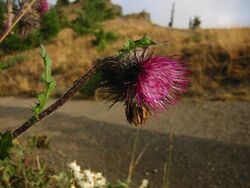Biology:Cirsium edule
| Cirsium edule | |
|---|---|

| |
| Scientific classification | |
| Kingdom: | Plantae |
| Clade: | Tracheophytes |
| Clade: | Angiosperms |
| Clade: | Eudicots |
| Clade: | Asterids |
| Order: | Asterales |
| Family: | Asteraceae |
| Genus: | Cirsium |
| Species: | C. edule
|
| Binomial name | |
| Cirsium edule | |
| Synonyms[1] | |
| |

Cirsium edule, the edible thistle[2] or Indian thistle,[3] is a species of thistle in the genus Cirsium, native to western North America from southeastern Alaska south through British Columbia to Washington (state) and Oregon, and locally inland to Idaho.[4] It is a larval host to the mylitta crescent and the painted lady.[5]
Cirsium edule is a tall herbaceous perennial plant, reaching 1–2 m (39–79 in) in height. The leaves are very spiny, lobed, 10–30 cm long and 2–5 cm broad (smaller on the upper part of the flower stem). The inflorescence is 3–4 cm diameter, purple, with numerous disc florets but no ray florets. The achenes are 4–5 mm long, with a downy pappus which assists in wind dispersal. It is monocarpic, growing as a low rosette of leaves for a number of years, then sending up the tall flowering stem in spring, with the plant dying after seed maturation.[6]
Edible thistle is used by Native Americans for its edible roots and young shoots. The roots are sweet, but contain inulin, which gives some people digestive problems.[7]
- Cirsium edule var. edule - Oregon, Washington (state)
- Cirsium edule var. macounii (Greene) D.J.Keil - Oregon, Washington (state) , British Columbia, Alaska
- Cirsium edule var. edule wenatchense D.J.Keil - Washington (state) [8]
References
- ↑ 1.0 1.1 The Plant List, Cirsium edule Nutt.
- ↑ "Cirsium edule". Natural Resources Conservation Service PLANTS Database. USDA. https://plants.usda.gov/core/profile?symbol=CIED. Retrieved 17 January 2016.
- ↑ (xls) BSBI List 2007, Botanical Society of Britain and Ireland, https://bsbi.org/download/3542/, retrieved 2014-10-17
- ↑ Biota of North America Program 2014 state-level distribution map
- ↑ The Xerces Society (2016), Gardening for Butterflies: How You Can Attract and Protect Beautiful, Beneficial Insects, Timber Press.
- ↑ 6.0 6.1 Flora of North America, Edible thistle, cardon, Cirsium edule Nuttall, Trans. Amer. Philos. Soc., n. s. 7: 420. 1841.
- ↑ Plants for a Future: Cirsium edule
- ↑ Keil, David John 2004. Sida 21(1): 213
External links
- Turner Photographics Pacific Northwest Wildflowers
- Lady Bird Johnson Wildflower Center, University of Texas
- Calphotos photo gallery, University of California
- Paul Slichter, Thistles East of the Cascade Mountains, Indian Thistle, Edible Thistle Cirsium edule var. wenatchense
Wikidata ☰ Q5122057 entry
 |

